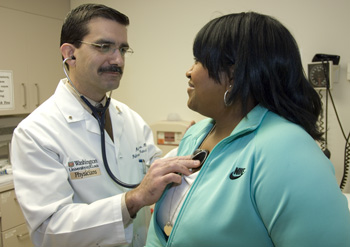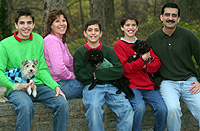For Mario Castro, M.D., one of the best moments of 2007 was watching the first relaxed, even breaths of a newborn girl in a rural Honduran clinic.
On the first day of a medical mission to Juticalpa, Honduras — a town three hours by bus from the nearest facility with a lung specialist — Castro and his colleagues were faced with the premature baby, who was in respiratory distress and needed help fast.

“She was struggling hard to breathe,” says Castro, who treats adults with asthma and other lung disorders at the School of Medicine. “Joan Downey, a specialist in newborn medicine, was with us and showed us how to rig up a system to give them lightly pressurized oxygen using just an oxygen tank and supplies that you can pick up at a hardware store. In just 48 hours, the baby was breathing easily on her own. That one moment made the trip very worthwhile.”
Castro, associate professor of medicine, is a board member of the International Medical Assistance Foundation (IMAF), a St. Louis-based group that funds the medical missions to Honduras, one of the poorest countries in the world. Once a year, he travels to Honduras with the organization’s Pulmonary and Allergy Brigade.
“Last year, we saw 150-200 people per day,” says Downey, M.D., assistant professor of pediatrics. “Yet the mission was very efficient, very well organized — largely due to Mario’s efforts. He’s extremely committed and very generous.”
IMAF’s goal is to provide specialist services that can’t be provided by the Honduran medical system. Downey says the teams bring badly needed supplies and leave behind the capacity for the Honduran doctors and nurses to continue interventions.
“We’ve noticed over the eight years we’ve been going there that the respiratory patients returning to the clinic are healthier,” Castro says. “They have much better control of their asthma, and their doctors are better aware of how to treat them. We get the feeling we’re making a real difference.”
Castro is the director of the Asthma and Airway Translational Research Unit, which coordinates the School of Medicine’s asthma research.
“Mario has become one of the world’s leading clinicians and clinical investigators for asthma,” says Michael Holtzman, M.D., the Selma and Herman Seldin Professor of Medicine and director of the Division of Pulmonary and Critical Care Medicine.
“He is one of those rare individuals who is able to combine an expertise in individual patient care with a keen sense of the important issues for public health,” Holtzman says. “His contributions have been critical for the success of the asthma research program both here and in multi-center clinical research networks that he has helped to establish throughout the country.”
Flight from Cuba
Castro was born in 1964 in Matanzas, a small town west of Havana, Cuba. Fidel Castro (no relation) had been in power for five years, and when Fidel Castro embraced communism in 1965, Mario Castro’s parents fled the country with their eight-month old son and his two older brothers.
|
Mario Castro |
|
How he met his wife, Marianne: Interests: Runs half marathons, plays racquetball, spends time with his children, entertains the family’s three dogs, goes on family vacations to such places as Yellowstone Park, Carlsbad Caverns and the Grand Canyon
Other duties:
Latest project:
|
The Cuban government confiscated everything Castro’s parents owned, including his father’s bakery, which had been in the family for generations. A Baptist church in Kansas City adopted the fugitive family, set them up in a house near the church and helped Castro’s parents find employment.
“We lived in poverty when we came here, and my parents had to work tough jobs,” Castro says. “That made me realize you have to work hard to achieve what you want in life. And my background makes me want to give back to society and give back to my culture.”
Castro’s medical missions to Honduras are part of that endeavor, as is his monthly volunteer work at La Clinica in St. Louis, a free clinic serving Hispanic refugees and immigrants. He and his wife, Marianne, have talked about how to instill similar values in their three sons: Benjamin, 16, Darrian, 13, and Victor, 11.
“Eventually, we would like them all to go on their own missions,” Castro says. “We are trying to time the mission next year so that one of my sons can go. It can be an eye-opening experience.”
The lessons Castro wants his sons to learn aren’t just about the value of hard work and about helping those in need. He says he also wants them to see how differently society functions in poorer countries.
“In some ways, they are richer than we are,” Castro says. “They have the church and town square in the center of town. People go there on weekends and talk and play games. There’s a strong sense of community.”
The ideals of family and community run throughout Castro’s daily life. Colleague and friend Leonard B. Bacharier, M.D., associate professor of pediatrics, describes Castro as a well-rounded person.
“Although he’s very driven, Mario is also very dedicated to family and attends as many of his kids’ sporting events as possible,” Bacharier says. “He’s proof that you can balance an academic workload with patient care and still have time for family.”
Tackling asthma
Raised in Kansas City, Castro also attended medical school there, earning a medical degree through the University of Missouri’s B.A/M.D. program, one of the few of its kind in the country. After graduating in 1988, he completed a residency in internal medicine and a fellowship in pulmonary and critical care medicine at the Mayo Clinic in Rochester, Minn.
He came to the School of Medicine in 1994 as an assistant professor of medicine. In 1998, he earned a master’s in public health from Saint Louis University while continuing his work. He was named associate professor in 2002.
Asthma affects about 16 million adults and 7 million children in the United States and has been increasing over the past two decades in spite of the availability of more effective drugs for its treatment. Each year, 4,000-5,000 Americans die from the effects of the disease.

Castro is involved in more than 20 ongoing studies focusing on the genetic, biological and immunological origins of asthma and how to reduce the suffering and death associated with the disease. He also has established an extensive research database that catalogs patients’ physiological information, tissue samples and genetic data for use in numerous research projects.
One of his projects, RSV Bronchiolitis in Early Life (RBEL), follows a group of St. Louis-area children to see if a severe lung infection with respiratory syncytial virus (RSV) early in life is associated with higher rates of asthma.
“We’re studying how the children’s immune systems respond to the virus,” Castro says. “But we’re also collecting information about the children’s environments, like the kind of dust found in their homes. The project started with a focus on RSV but has spawned two additional projects.”
Bacharier has been working with Castro for about 10 years on projects related to childhood asthma, including the RBEL study.
“Mario is an expert on the effect of viral infection on the lung, and he is dedicated to the science of how this happens,” Bacharier says. “He is well informed and has a lot of good ideas — and he seems to have endless energy. No one else I know in the field tackles asthma from so many angles: basic science, clinical therapy, community intervention and public health.”
Castro works with people experiencing a wide range of asthma symptoms. That could include people who are very disabled by their condition or elite athletes whose asthma limits their performance.
“What’s always been joyful to me about taking care of asthma patients is that no matter their initial condition, I can usually make them feel better and allow them to function at a much higher level,” Castro says.
“I also like the challenge of working to prevent this disease,” he says. “That’s one of those frontiers we haven’t crossed yet, and, in my lifetime, I believe that we can achieve it.”